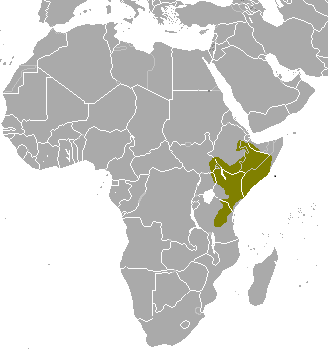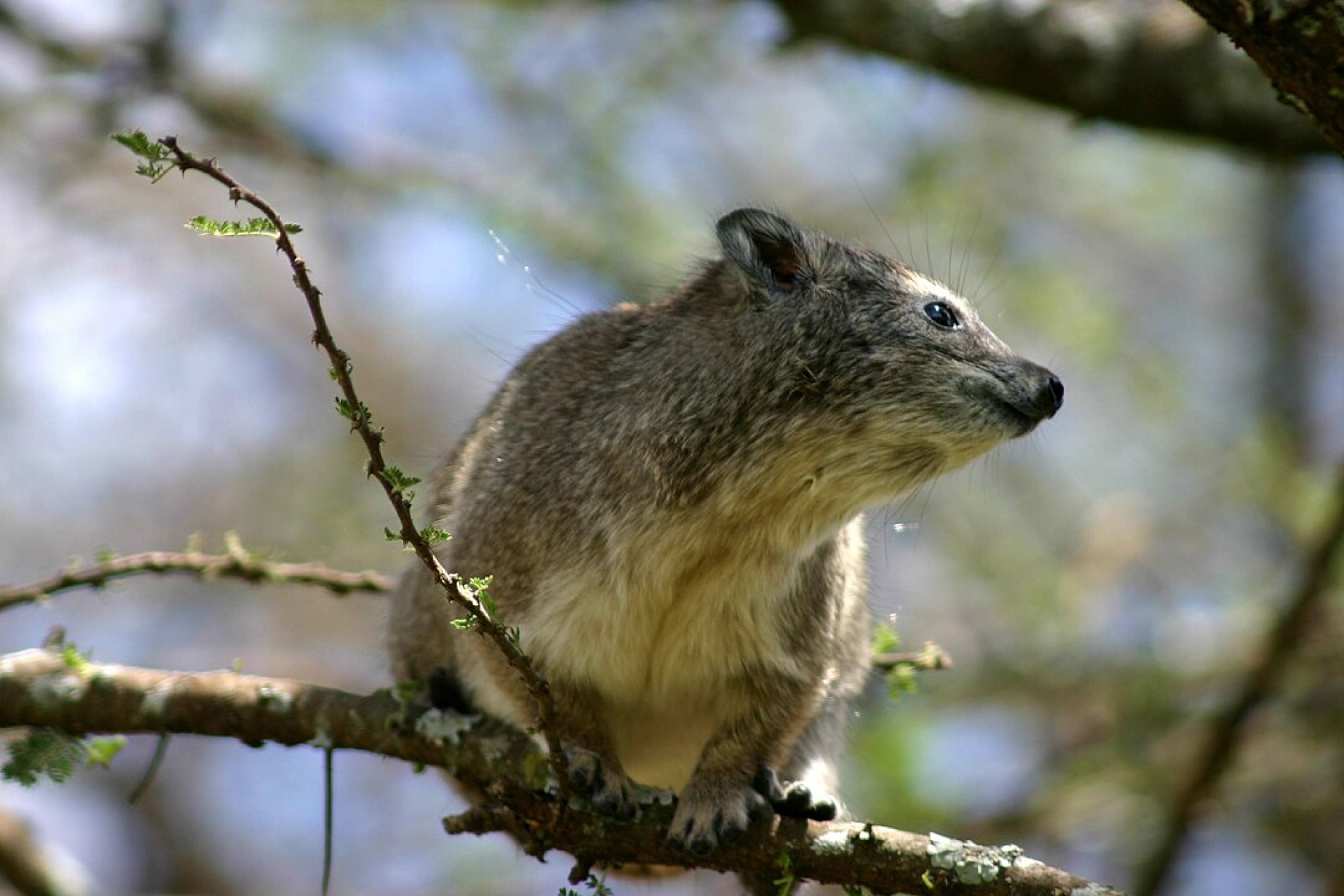The Tapanuli Orangutan, was only described in 2017 and makes the eighth species of great ape. Unfortunately, it only numbers 800 in the wild, and a dam threatens its future survival.
Click on its underlined name to visit its page. Do get in touch, if you work in conservation of this species, or tourism around its habitat, we are eager to help people visit, and support its continued survival.


 known as
known as 






 The bongo is a large, mostly nocturnal, forest-dwelling antelope, native to sub-Saharan Africa. Bongos are characterised by a striking reddish-brown coat, black and white markings, white-yellow stripes, and long slightly spiralled horns. It is the only member of its family in which both sexes have horns. Bongos have a complex social interaction and are found in African dense forest mosaics. They are the third-largest antelope in the world.
The bongo is a large, mostly nocturnal, forest-dwelling antelope, native to sub-Saharan Africa. Bongos are characterised by a striking reddish-brown coat, black and white markings, white-yellow stripes, and long slightly spiralled horns. It is the only member of its family in which both sexes have horns. Bongos have a complex social interaction and are found in African dense forest mosaics. They are the third-largest antelope in the world.





 swamp-dwelling medium-sized antelope found throughout central Africa (see the map to the right. The sitatunga is mostly confined to swampy and marshy habitats. Here they occur in tall and dense vegetation as well as seasonal swamps, marshy clearings in forests, riparian thickets and mangrove swamps.
swamp-dwelling medium-sized antelope found throughout central Africa (see the map to the right. The sitatunga is mostly confined to swampy and marshy habitats. Here they occur in tall and dense vegetation as well as seasonal swamps, marshy clearings in forests, riparian thickets and mangrove swamps.
 Rock or cape hyrax has 5 recognized subspecies, again, unsurprising given its vast range. Generally having a hide within a natural rock cavity, Rock hyraxes are social animals that live in colonies of up to 50 individuals. They sleep in one group, and start the day, warming up in the sun
Rock or cape hyrax has 5 recognized subspecies, again, unsurprising given its vast range. Generally having a hide within a natural rock cavity, Rock hyraxes are social animals that live in colonies of up to 50 individuals. They sleep in one group, and start the day, warming up in the sun
 Western tree hyrax, also known as the western tree dassie or Beecroft tree hyrax
Western tree hyrax, also known as the western tree dassie or Beecroft tree hyrax

 Eastern tree hyrax is the most localized of the tree hyrax species, only found in places within a narrow band of lowland and montane forests in
Eastern tree hyrax is the most localized of the tree hyrax species, only found in places within a narrow band of lowland and montane forests in 
 Southern tree hyrax It is found in temperate forests, subtropical or tropical dry forests, subtropical or tropical moist lowland forests, subtropical or tropical moist montane forests, moist savanna, and rocky areas.
Southern tree hyrax It is found in temperate forests, subtropical or tropical dry forests, subtropical or tropical moist lowland forests, subtropical or tropical moist montane forests, moist savanna, and rocky areas.


 This is a species of rat-like porcupine, found in a broad belt of Equatorial Africa, right across the continent from Guinea to
This is a species of rat-like porcupine, found in a broad belt of Equatorial Africa, right across the continent from Guinea to 

 porcupine, (also called the African crested porcupine) is native to North Africa (though it may be locally extinct in Egypt) and sub-Saharan Africa. It is also found in
porcupine, (also called the African crested porcupine) is native to North Africa (though it may be locally extinct in Egypt) and sub-Saharan Africa. It is also found in  porcupine is a rodent species native to southern Asia and the Middle East. It weighs 11-18kg and is 70-90cm long. It has similar looking quills to the African Porcupine, and has a similar diet.
porcupine is a rodent species native to southern Asia and the Middle East. It weighs 11-18kg and is 70-90cm long. It has similar looking quills to the African Porcupine, and has a similar diet. porcupine or Himalayan porcupine is a species of rodent. The head and body measurement are around 56-74 cm and the tail is about 6–11 cm. They weigh around 10 kg-18 kg. They normally feed on roots, tubers, bark and fallen fruits. They also eat carrion, insects, and large tropical seeds. They forage at night and rests during the day. It may be found singly or in pairs. It can also swim and gnaw. The sow usually has one, but twins have also been recorded.
porcupine or Himalayan porcupine is a species of rodent. The head and body measurement are around 56-74 cm and the tail is about 6–11 cm. They weigh around 10 kg-18 kg. They normally feed on roots, tubers, bark and fallen fruits. They also eat carrion, insects, and large tropical seeds. They forage at night and rests during the day. It may be found singly or in pairs. It can also swim and gnaw. The sow usually has one, but twins have also been recorded.
 porcupine is a species of rodent. It is endemic to Indonesia. Due to the popularity of the hunting and consumption of the Sunda porcupine as an aphrodisiac, the Ministry of Environment and Forestry in Indonesia has listed this species as a protected animal as of June 2018.
porcupine is a species of rodent. It is endemic to Indonesia. Due to the popularity of the hunting and consumption of the Sunda porcupine as an aphrodisiac, the Ministry of Environment and Forestry in Indonesia has listed this species as a protected animal as of June 2018. porcupine
porcupine  (also called Palawan porcupine) is a species of rodent endemic to the island of Palawan in the Philippines. It is known locally as durian or landak.
(also called Palawan porcupine) is a species of rodent endemic to the island of Palawan in the Philippines. It is known locally as durian or landak. or Quichua porcupine is a species of rodent. It is found in the Andes of northern
or Quichua porcupine is a species of rodent. It is found in the Andes of northern  porcupine (Coendou bicolor) is a species of nocturnal and arboreal rodent in the family Erethizontidae.
porcupine (Coendou bicolor) is a species of nocturnal and arboreal rodent in the family Erethizontidae. also called Koopman’s porcupine, is a porcupine species from the New World and is endemic to northern Brazil. It occurs in the Amazon rainforest east of the Madeira River and south of the Amazon River. It inhabits primary forest and possibly second growth. It was described as Coendou koopmani by Charles O. Handley Jr. and Ronald H. Pine in 1992, but was subsequently found to be identical to a species described in 1818. It is nocturnal and herbivorous.
also called Koopman’s porcupine, is a porcupine species from the New World and is endemic to northern Brazil. It occurs in the Amazon rainforest east of the Madeira River and south of the Amazon River. It inhabits primary forest and possibly second growth. It was described as Coendou koopmani by Charles O. Handley Jr. and Ronald H. Pine in 1992, but was subsequently found to be identical to a species described in 1818. It is nocturnal and herbivorous.










